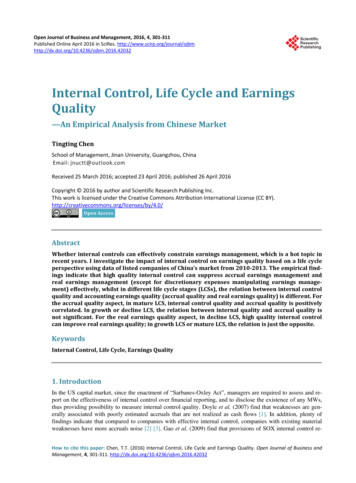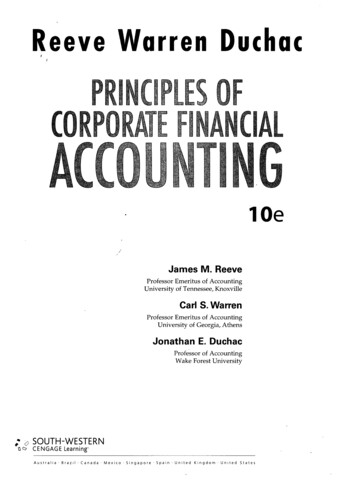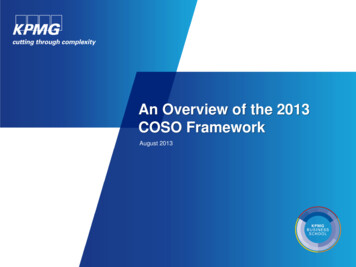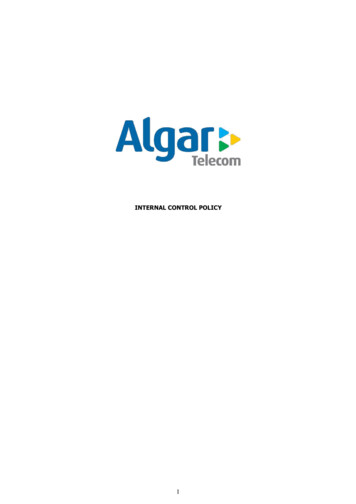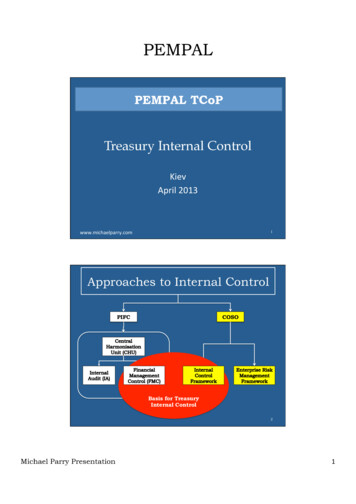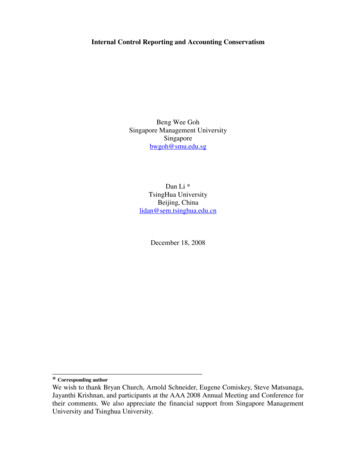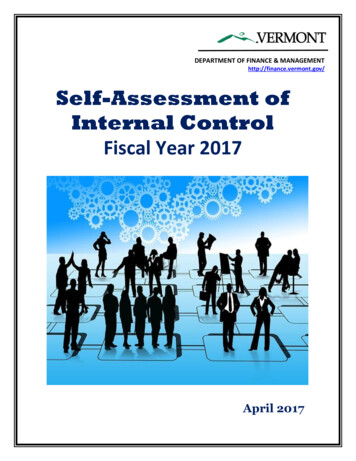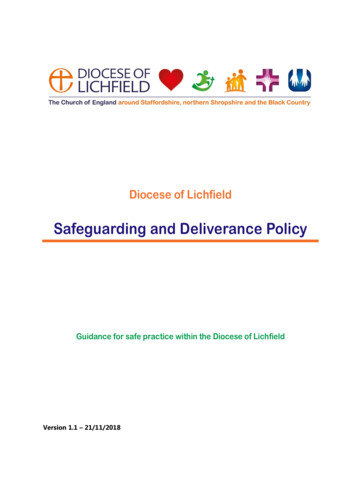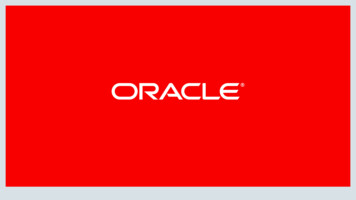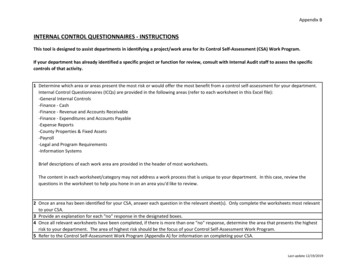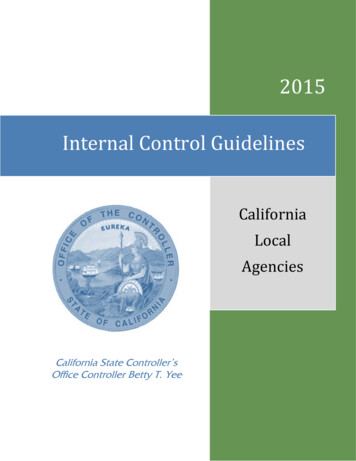
Transcription
2015Internal Control GuidelinesCaliforniaLocalAgenciesCalifornia State Controller’sOffice Controller Betty T. Yee
State Controller’s OfficeInternal Control GuidelinesFOREWORDCalifornia Government Code (GC) section 12422.51 requires the State Controller to develop internalcontrol guidelines applicable to each local agency. The intent of the legislation is to assist local agenciesin establishing a system of internal control to safeguard assets and prevent and detect financial errors andfraud. However, there is no requirement that the tools developed must be used in the form provided.A local agency includes a city, county, city and county, special district or any other local governmententity, except a school district. In this document, these entities are referred to as local governments.The California Society of Certified Public Accountants took a lead role in developing the internal controlguidelines based on standards adopted by the American Institute of Certified Public Accountants(AICPA). The State Controller’s Office worked closely with the California Society of Certified PublicAccountants and received valuable input from organizations representing the interests of localgovernments, (i.e. League of California Cities, California State Association of Counties, CaliforniaSpecial Districts Association, California State Association of County Auditors, and California CommonSense to complete the internal control guidelines.Although GC section 12422.5 specifically cites the AICPA standards, the internal control guidelinesincorporate or reference other internal control standards and practical guidance (i.e. U.S. GovernmentAccountability Office [GAO], Office of Management and Budget [OMB], Committee of SponsoringOrganizations of the Treadway Commission [COSO] Internal Control Standards, Institute of InternalAuditors [IIA], Government Finance Officers Association Best Practices, etc.). For additional informationon Internal Controls please refer to the following:GAO - http://www.gao.gov/greenbook/overviewGAO - http://www.gao.gov/products/GAO-01-1008GGAO - http://www.gao.gov/yellowbook/overviewOMB - http://www.whitehouse.gov/ombCOSO - http://www.coso.org/IC.htm1(a) On or before January 1, 2015, the Controller shall develop internal control guidelines applicable to each localagency to prevent and detect financial errors and fraud.(b) The Controller shall develop the internal control guidelines based on standards adopted by the AmericanInstitute of Certified Public Accountants and with input from any local agency and organizations representingthe interests of local agencies, including, but not limited to, the League of California Cities, the CaliforniaState Association of Counties, the California Special Districts Association, and the California StateAssociation of County Auditors.(c) On or before January 1, 2015, the Controller shall post the completed internal control guidelines on theController’s Internet Web site to assist a local agency, as defined in subdivision (e), in establishing a system ofinternal controls to safeguard assets and prevent and detect financial errors and fraud.(d) The Controller shall, with input from the agencies listed in subdivision (b), update the internal controlguidelines, as he or she deems necessary, and maintain a current version on the Internet Web site.(e) For purposes of this section, “local agency” means a city, county, city and county, special district, or any otherlocal governmental entity, except a school district.
State Controller’s OfficeInternal Control GuidelinesIIA - ndards-and-Guidance-IPPF.aspxGFOA - http://www.gfoa.org/best-practicesThese guidelines do not include an “Internal Control Questionnaire” or an “Internal Control Checklist”;however, we recommend using the GAO’s Internal Control Standards, Internal Control Management andEvaluation Tool (http://www.gao.gov/products/GAO-01-1008G). The tool provides useful guidance forevaluating an agency’s internal control and is intended to help management determine how well anagency’s internal control is designed and functioning and how improvements can be implemented. Wealso recommend using COSO’s Internal Control – Integrated Framework 2013. The framework definesinternal control, describes requirements for effective internal control including components and relevantprinciples, and provides direction for all levels of management to use in designing, implementing, andassessing its effectiveness. The Executive Summary can be downloaded from COSO’s websitehttp://www.coso.org/IC.htm, however the Framework and Appendices, and Illustrative Tools forAssessing Effectiveness of a System of Internal Control (three-volume set) can be purchased.The internal control guidelines are posted on the State Controller's Office website and will be updatedperiodically, as he or she deems necessary.
State Controller’s OfficeInternal Control GuidelinesTABLE OF CONTENTSIntroduction .1Control Environment .1Risk Assessment .4Control Activities .5Information and Communication .9Monitoring Activities .12
State Controller’s OfficeInternal Control GuidelinesIntroductionThe American Institute of Certified Public Accountants’ (AICPA’s) Auditing Standard AU-C §315.04defines internal control based on the definition and description contained in Internal Control – IntegratedFramework, published by the Committee of Sponsoring Organizations of the Treadway Commission(COSO) as follows:A process effected by those charged with governance, management, and other personnel that isdesigned to provide reasonable assurance about the achievement of the entity’s objectives withregard to the reliability of financial reporting, effectiveness and efficiency of operations, andcompliance with applicable laws and regulations. Internal control over safeguarding of assetsagainst unauthorized acquisition, use or disposition may include controls relating to financialreporting and operations objectives.Internal control is comprised of five components that work together in an integrated framework: Control Environment; Risk Assessment; Control Activities; Information and Communication; and Monitoring Activities.The objectives of the five components are defined below along with examples of methods that may beused by a local government to address each component. However, these are guidelines and it is importantto note that the actual methods implemented to address the components of internal control need to bescaled to each particular local government and expanded or contracted based on the local government’sorganizational structure, staffing levels, programs, and resources. It is not expected that all localgovernments will use all of the example methods of implementation that have been identified for eachcomponent. In addition, some local governments may use other policies or procedures in their system ofinternal control in lieu of the examples provided in these guidelines.Control EnvironmentThe Objectives of Control Environment:The AICPA’s Auditing Standard AU-C §315.A71 defines control environment as:The control environment includes the governance and management functions and the attitudes,awareness, and actions of those charged with governance and management concerning theentity’s internal control and its importance in the entity. The control environment sets the tone ofan organization, influencing the control consciousness of its people. It is the foundation for allother components of internal control, providing discipline and structure.The control environment is the set of standards, processes, and structures that provide the basis forcarrying out internal control across the entity. The governing board and management establish the “toneat the top” regarding the importance of internal control, including expected standards of conduct, whichthen cascade down throughout the various levels of the organization and have a pervasive effect on theoverall system of internal control. The control environment extends beyond the idea of culture andcomprises the following: The organization’s integrity and ethical values;1
State Controller’s OfficeInternal Control Guidelines The governing board’s oversight responsibilities; The assignment of authority and responsibility; The process for attracting, developing, and retaining employees; and The measures, incentives, and rewards to drive accountability for performance.A local government’s control environment is influenced by a variety of factors including its history,values, market, and the competitive and regulatory landscape. Also, a local government that establishesand maintains a strong control environment positions itself to be more resilient in the face of internal andexternal pressures.Examples of Methods That May be Used by a Local Government to Address Control Environment:Below are examples of how a local government might establish its control environment process. Theseare only examples and some local governments might use other methods to meet the objectives of controlenvironment:Local governments may use policies and procedures to promote and maintain a proper controlenvironment. In some cases these policies and procedures are established as a matter of practice. In othercases, these policies and procedures are in writing, perhaps in the form of a policy manual or anelectronic library of documents to aid the local government in providing a basis for training personnel,communicating and providing a source of reference to approved policies, and maintaining consistency ofrecording financial transactions.A local government’s policies and procedures should include some or all of the following elements:Organization’s Integrity and Ethical Values1. Develop, widely distribute, and practice a code of conduct.2. Establish the values and operating style for the organization and communicate to all employeesthrough various methods, such as by example, the code of conduct, policies, and procedures.3. Consistently communicate to management personnel the importance of integrity and ethical values.4. Ensure that the board and management receive and update their ethics training as required by AB1234Governing Board’s Oversight Responsibilities1. Identifies and accepts its oversight responsibilities.2. Ensures that management has the skills, knowledge, and experience necessary for their job duties.3. Applies skepticism and is objective in evaluating management and when making decisions.4. Ensures the completion of periodic risk assessments.5. Follows up on the status of audit findings.6. Establishes an audit committee.2
State Controller’s OfficeInternal Control GuidelinesAssignment of Authority and Responsibility1. Consider the structure of the organization in terms of its size and the nature of its operation.2. Establish reporting lines to enable execution of authorities, responsibilities, and flow of informationto manage the activities of the organization.3. Use appropriate processes and technology to assign responsibility and segregate duties as necessary atall levels of the organization.a. The governing board should retain authority over significant decisions and review managementassignments and any limitations of management’s authority and responsibilities.b. Management should establish directives, guidance, and control to enable management and otherpersonnel to understand and carry out their internal control responsibilities.c. Personnel should understand the organization’s operational style and the code of conduct andcarry out management’s plan of action to achieve the objectives.Process for Attracting, Developing, and Retaining Employees1. Establish policies and practices reflecting expectations of competence.2. Evaluate competence across the organization.3. Provide the mentoring and training needed to attract, develop, and retain sufficient and competentpersonnel.a. Attract – Seek out candidates who fit the organization’s needs and possess the competence forthe position.b. Develop – Enable individuals to develop competencies appropriate for assigned roles andresponsibilities. Establish expectations and tailor training based on roles and needs.c. Mentor – Guide employee performance toward expected standards of conduct and competence,and align the employee’s skills and expertise with the organization’s objectives.d. Evaluate – Measure the performance of employees in relation to achievement of objectives anddemonstration of expected conduct.e. Retain – Provide incentives to motivate and reinforce expected performance.4. Develop contingency plans to ensure that candidates for succession are trained and coached forassuming the target role so that internal controls do not lapse.Accountability for Performance1. Establish mechanisms to communicate and hold individuals accountable for performance of internalcontrol responsibilities across the organization and implement corrective actions as necessary.2. Establish performance measures and incentives appropriate for responsibilities at all levels of theorganization.3
State Controller’s OfficeInternal Control Guidelines3. Perform evaluations timely and align incentives with the fulfillment of internal controlresponsibilities.Risk AssessmentThe Objectives of Risk Assessment:The AICPA’s Auditing Standard AU-C §315.A81 defines risk assessment as:An entity’s risk assessment process for financial reporting purposes is its identification, analysis,and management of risks relevant to the preparation and fair presentation of financial statements.A local government’s risk assessment process includes how management identifies risks (including fraudrisk) relevant to the preparation and fair presentation of financial statements in accordance with the localgovernment’s applicable financial reporting framework, estimates the significance of each risk, assessesthe likelihood of the occurrence, and decides upon actions to respond to and manage them and the resultsthereof.Risks relevant to reliable financial reporting include external and internal events, as well as transactionsor circumstances that may occur and adversely affect a local government’s ability to initiate, authorize,record, process, and report financial data consistent with the assertions of management.Examples of Methods That May Be Used by a Local Government to Address Risk Assessment:Below are examples of how a local government might manage its risk assessment process. These are onlyexamples and some local governments might use other methods to meet the objectives of risk assessment:1. Some local governments should address risk assessment in conjunction with the supervision ofpersonnel. When providing direction to personnel in the performance of their duties, managementmay identify information as to the types of errors, policy violations, fraud, or noncompliance to whichthey should be attentive in the performance of their duties.2. Other local governments may have a more formal risk assessment process that includes one or moreof the following elements:a. The identification of objectives relevant to the reduction of errors, policy violations, fraud, ornoncompliance. This is sometimes communicated to employees by means of the posting ofcertain organizational policies and procedures.b. When errors or violations of policy occur or are identified, the local government should respondto this increase in risk by communicating to appropriate persons within the organization the needto be vigilant with respect to these identified areas of risk.c. The local government should report to department heads after each governing board meeting tocommunicate new or changed risks, conditions, actions, or events that may impact the ability ofdepartments to manage the risks relevant to the operation.d. Finance personnel should attend accounting training sessions to become aware of new accountingpronouncements and emerging issues in order to further identify and manage risks associatedwith proper financial reporting.4
State Controller’s OfficeInternal Control Guidelinese. Departments should send staff to conferences and program training sessions for the purpose ofidentifying likely risks of noncompliance, fraud, and error relevant to the programs that theymanage. These persons should disseminate this information to other persons in their department.f.The Information Technology (IT) department should periodically identify and communicate risksfor which employees should be particularly vigilant.g. Changes in software should be subject to extensive evaluation and testing in order to identify andmanage risks associated with use.h. The budget should be used as a means to anticipate, identify, and react to changes in conditionsthat may increase the risk of misstatement.i.During the year end closing process, the local government should identify for those personnelinvolved in the closing process the objectives of financial reporting and the likely errors that areassociated with each individual’s role in that process. This would include identifying the types ofnonstandard transactions that merit special consideration or consultation to ensure that all aspectsof generally accepted accounting principles associated with those transactions are properlyattended to.j.Management should identify for its staff those parties that have transactions with the localgovernment for which there is a potential conflict of interest due to members of management orelected officials having a relationship with those parties.k. Throughout the year, management maintains a list of information, conditions, transactions, andevents that may increase the risk of accounting error or fraud in order to evaluate the effects ofsuch matters and to properly communicate these matters to the local government’s independentauditors. These include new laws or legislation, major changes in government operations, majoror unusual transactions, actions of the governing board, new agreements, new joint ventures, assetimpairments, new responsibilities for pollution remediation, major changes in executivemanagement, staff reductions that might affect internal controls, major changes in thegovernment’s service area, the acquisition of utility systems, new material revenue sources or feestructures, changes in the collectability of loans made to others, regulatory inquiries or audits,significant intra-entity transactions, major changes in the local economy, etc.Control ActivitiesThe Objectives of Control Activities:The AICPA’s Auditing Standard AU-C §315.A91 defines control activities as:Control activities are the policies and procedures that help ensure that management directives arecarried out. Control activities, whether within IT or manual systems, have various objectives andare applied at various organizational and functional levels. Examples of specific control activitiesinclude those relating to the following: Authorization Performance reviews Information processing Physical controls Segregation of duties5
State Controller’s OfficeInternal Control GuidelinesLocal governments should establish policies and procedures to implement control activities that achievemanagement directives and respond to identified risks in the internal control system. Control activitiescan be categorized as policies and procedures that pertain to the following:Authorization – activities should be authorized in accordance with the local government’s policies andprocedures.Performance Reviews – local government should perform analyses of financial data, including comparingactual results to budget forecasts and historical data, to ensure variances are in accordance withexpectations, considering internal and external factors.Information Processing – two aspects, Application Controls and General IT Controls, which relate to theoverall effectiveness of IT controls to ensure the proper operation of the local government’s informationsystems.Application Controls are those related to procedures to check the accuracy of the output data, includingfollow-up on exceptions. Application controls are designed to help ensure completeness, accuracy,authorization, and validity of all transactions during application processing. It includes both the routinescontained within the computer program code as well as the policies and procedures associated with useractivities such as entering data, and producing or reporting results.General IT Controls involve maintaining control procedures to restrict the access to the program data andthe ability to make modifications to the data, including software updates and back-up or disaster recoveryprocedures, to ensure the continued operation of the information systems. General controls are needed toensure the function of application controls, which depend on computer processing, and includes thestructure, policies, and procedures that apply to the agency’s overall computer operations. It applies to allinformation systems: mainframe, minicomputer, network, and end-user environments and can includecontrolled processes for system access, computer center or server operations, change management,incident response, business continuity, and backup and storage.Physical Controls – include ensuring the safeguarding of both tangible and intangible assets. The localgovernment should have policies that ensure the physical security over all assets, whether they be capitalassets, cash and investments, or other assets, and procedures to periodically count or reconcile the assetsto the records. In addition, access to computer programs or data files should be restricted to appropriatepersonnel.Segregation of Duties – the functions of authorization, recording or reconciling, and maintaining custodyof assets should be segregated.When designing policies and procedures to address control activities, the local government should keep inmind that the cost of implementing certain control activities should not exceed the benefit derived fromthe control activities.For some small local governments, segregation of duties may be a challenge. Review and approval by anappropriate second person may be the most important control activity. That second person may be amember of the governing body in a review or approval role.6
State Controller’s OfficeInternal Control GuidelinesExamples of Methods That May be Used by a Local Government to Address Control Activities:Below are examples of how a local government might implement control activities in specific areas. Eachlocal government will need to identify control activities and areas of risk specific to the local government.These are only examples of key controls in the areas noted and some local governments might use otherpolicies or procedures to meet the objectives of control activities in these and other areas.1. Cash Depositsa. Bank reconciliations are effective tools to detect mistakes, errors, or embezzlements if they areprepared timely, reviewed in detail, and approved by a second person.b. Transfers between accounts involve two people (one to initiate and one to approve), to preventmisappropriation of assets.c. To ensure proper segregation of duties, the person involved with the bank reconciliation shouldbe prohibited from performing the following duties:i.Collection of cash receipts in any form (cash, check, wire, electronic, credit card, etc.);ii. Deposit of cash collections with the bank;iii. Disbursements; andiv. Authorized signer on the account(s).2. Investmentsa. The purchase or sale of investments should require authorization prior to execution, to ensure thetransactions are in compliance with the local government’s investment policy, the GovernmentCode, or any other authoritative guidance regulating the purchase or sale.b. To safeguard investments, an investment safekeeper should be utilized.c. Performance of the investment portfolio should be reviewed periodically to ensure it is meetingthe objectives and expectations of the local government.3. Payroll (Compensation-related Disbursements)a. To ensure proper segregation of duties, access to the human resources module (add, delete, andmodify employee data) should be segregated from access to the payroll module (payrollprocessing).b. To ensure accuracy and authorization, a second person should be required to review and approvethe following:i.Timesheets;ii. Addition or deletion of employees;iii. Changes to the payroll data (existing employees);7
State Controller’s OfficeInternal Control Guidelinesiv. Time entry; andv. Payroll register.c. Internal financial reports should be reviewed and compared to budget on a periodic basis andvariances should be investigated.4. Non-compensation-related Disbursements/Procurementa. To ensure proper segregation of duties, access to the vendor database (add, delete, and modifyvendor data) may be segregated from access to the accounts payable module (disbursementsprocessing).b. Invoices should be checked for mathematical accuracy and approved for payment prior toprocessing.c. Check/warrant registers should be reviewed for accuracy by a person independent from theaccounts payable process and approved prior to finalization.d. Purchasing guidelines should be established that detail authorization limits, when contracts arerequired, and when purchases are subject to bidding or informal quotes. Otherwise, the applicablecontract procurement sections of the Government Code, or other authoritative guidelines, shouldbe followed.e. Positive pay, or a similar procedure, should be employed.f.Internal financial reports should be reviewed and compared to budget on a periodic basis andvariances should be investigated.5. Capital-related Expendituresa. Procedures should be established to ensure capital expenditures are authorized, identified, andcapitalized.b. Policies and procedures should be established to ensure that capital assets are safeguarded againstmisuse or theft.c. Periodic physical inventories should be performed to ensure that the records are accurate anddifferences investigated/explained. Inventory counts should be performed by a person that is notresponsible for safeguarding the assets and differences investigated/explained.d. Grant funded capital assets must be inventoried and maintained in accordance with applicablegrantor requirements.6. Revenuea. To ensure proper segregation of duties, the person responsible for the collection of customerpayments should be prohibited from being involved with, or having access to, the following:i.Producing customer bills or reimbursement requests;ii. Customer database (add, delete, and modify customer or rate data);8
State Controller’s OfficeInternal Control Guidelinesiii. Approving voided transactions; andiv. Posting receipts to the general ledger.b. Bills should be reviewed by a second person prior to issuance, on a sample basis at a minimum.c. When subsidiary ledgers are used, the detailed ledgers should be reconciled to the general ledgeron a periodic basis and any differences investigated.d. Internal financial reports should be reviewed and compared to budget on a periodic basis andvariances should be investigated.7. Debta. Policies should be established to define when the governing body or staff may authorize theissuance of long-term debt, including bonds, capital leases, loans, lines of credit, etc.b. Procedures should be established to ensure timely repayment and compliance with on-going debtcovenants.c. To ensure compliance with limitations on use, the use of debt proceeds should be subject toreview and approval.d. Trustee or bank accounts should be reconciled by a person not involved with the authorization forthe disbursement of debt proceeds.8. Financial Reportinga. A policy should be used to establish budgetary control and approval required for budgetamendments.b. Financial reports should be reviewed for accuracy.c. Financial reports should be periodically produced and distributed or made available todepartments and the governing body for review.d. Analyses of financial data, including comparing actual results to budget forecasts and prior yearactuals, should be performed to ensure variances are in accordance with expectations, consideringinternal and external factors. Any unexpected variances should be investigated.Information and CommunicationThe Objectives of Information and Communication:The AICPA’s Auditing Standard AU-C §315.A84 defines the information system as:The information system relevant to financial reporting objectives, which includes the accountingsystem, consists of the procedures and records designed and established to: initiate, authorize, record, process, and report entity transactions (as well as events andconditions) and maintain accountability for the related assets, liabilities, and equity; resolve incorrect processing of transactions (for example, automated suspense files andprocedures followed to clear suspense items out on a timely basis);9
State Controller’s OfficeInternal Control Guidelines process and account for system overrides or bypasses to controls; transfer information from transaction processing systems to the general ledger; capture information relevant to financial reporting for events and conditions other thantransactions, such as
also recommend using COSO's Internal Control - Integrated Framework 2013. The framework defines internal control, describes requirements for effective internal control including components and relevant principles, and provides direction for all levels of management to use in designing, implementing, and assessing its effectiveness.

